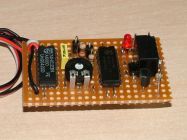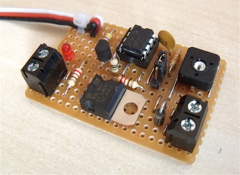
|
|
|
|
R/C SWITCHESThese are modules that can be connected to a channel output (using a Y lead if a servo is already being driven by that channel) to enable auxiliary functions such as lights, sounds, motors, pumps etc to be operated at a pre-determined point of that channel's proportional control or by a toggle switch if it is a digital control channel. They are the electronic counterparts of using a cam on a servo to operate a micro-switch, except that the operating point is more quickly and easily adjustable. Their use is not just limited to switching auxiliaries on and off - using my earlier 'analogue' versions of this switch design, one member configured the rudder channel on his twin motor tugboat to throw the appropriate motor into reverse for extreme rudder deflections in each direction. This achived splendid manoeuvrability without the cost and complexity of fitting twin ESCs and a rudder mixer module.
No circuit-board layout is offered as the relay choice will depend on the current switching capability required. Relays give the flexibility of floating contacts to wire anywhere into your system but if you are happy to switch your (uni-directional) load to the common Ov supply then the relay(s) can be omitted and power FET(s) substituted for the relay drive transistor(s).
|


